
Massachusetts Institute of Technology (MIT) is a private land-grant research university in Cambridge, Massachusetts. The institute has an urban campus that extends more than a mile (1.6 km) alongside the Charles River. The institute also encompasses a number of major off-campus facilities such as the MIT Lincoln Laboratory, the Bates Center, and the Haystack Observatory, as well as affiliated laboratories such as the Broad and Whitehead Institutes. Founded in 1861 in response to the increasing industrialization of the United States, MIT adopted a European polytechnic university model and stressed laboratory instruction in applied science and engineering. It has since played a key role in the development of many aspects of modern science, engineering, mathematics, and technology, and is widely known for its innovation and academic strength.

The Wiesner building houses the MIT Media Lab and the List Visual Arts Center and is named in honor of former MIT president Jerome Wiesner and his wife Laya. The building is very box-like, a motif that is consistently repeated in both the interior and exterior design evoking a sense of boxes packed within each other.
Massachusetts College of Art and Design, branded as MassArt, is a public college of visual and applied art in Boston, Massachusetts. Founded in 1873, it is one of the nation’s oldest art schools, the only publicly funded free-standing art school in the United States, and was the first art college in the United States to grant an artistic degree. MassArt is a member of the Colleges of the Fenway, and the ProArts Consortium.

Kresge Auditorium is an auditorium structure at the Massachusetts Institute of Technology, located at 48 Massachusetts Avenue, Cambridge, Massachusetts. It was designed by the Finnish-American architect Eero Saarinen, with ground-breaking in 1953 and dedication in 1955. The building was named for its principal funder, Sebastian S. Kresge, founder of S. S. Kresge Stores and the Kresge Foundation.

The Cecil and Ida Green Building, also called the Green Building or Building 54, is an academic and research building at the Massachusetts Institute of Technology (MIT) in Cambridge, Massachusetts. The building houses the Department of Earth, Atmospheric, and Planetary Sciences (EAPS). It is one of the tallest buildings in Cambridge.
The MIT Program in Art, Culture and Technology (ACT) has its origins in the Center for Advanced Visual Studies (CAVS) at the Massachusetts Institute of Technology (MIT), an arts and research center founded in 1967 by artist and teacher György Kepes. In 2009, CAVS merged with the MIT Visual Arts Program, to become the MIT Program in Art, Culture and Technology (ACT). The Program is part of the MIT School of Architecture and Planning.

The campus of the Massachusetts Institute of Technology is located on a 168-acre (68 ha) tract in Cambridge, Massachusetts, United States. The campus spans approximately one mile (1.6 km) of the north side of the Charles River basin directly opposite the Back Bay neighborhood of Boston, Massachusetts.
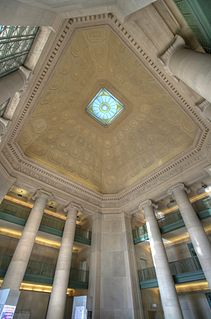
The MIT School of Architecture and Planning is one of the five schools of the Massachusetts Institute of Technology, located in Cambridge, Massachusetts. Founded in 1865 by William Robert Ware, the School offered the first formal architectural curriculum in the United States, and the first architecture program in the world operating within the establishment of a University. MIT SAP is considered a global academic leader in the design fields and one of the most prestigious schools in the world. MIT's Department of Architecture has consistently ranked among the top architecture/built environment schools in the world, and from 2015-2018 was ranked highest in the world in QS World University Rankings. In 2019, it was ranked second to The Bartlett but regained the number one position in the 2020 rankings.
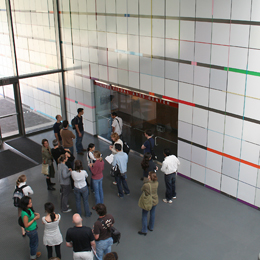
Established in 1985, the List Visual Arts Center (LVAC) is the contemporary art gallery of the Massachusetts Institute of Technology. It is known for temporary exhibitions in its galleries located in the MIT Media Lab building, as well as its administration of the permanent art collection distributed throughout the university campus, faculty officies, and student housing.

Jacqueline S. Casey was a graphic designer best known for the posters she created for the Massachusetts Institute of Technology (MIT). While practicing a functional Modernism, Jacqueline S. Casey was a graphic designer in the Office of Publications from 1955 to 1989 and assigned the position as director in 1972. In discussing her design, Casey stated, "My work combines two cultures: The American interest in visual metaphor on the one hand, and the Swiss fascination with planning, fastidiousness, and control over technical execution on the other."
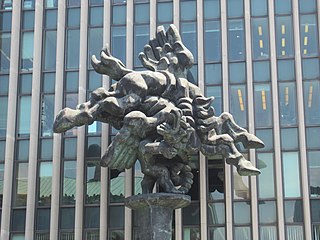
Bellerophon Taming Pegasus is an outdoor sculpture by Jacques Lipchitz, depicting Bellerophon and Pegasus. It was the final sculpture worked on by Lipchitz, and was completed after his death in 1973.

Trigger 4, also known as Trigger Four, is an outdoor 1979 steel sculpture by Lee Kelly, located on the Reed College campus in Portland, Oregon.
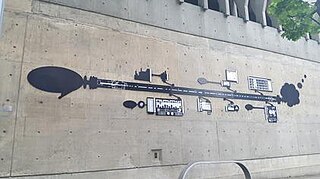
Conduit is an outdoor 2009–2010 mural by Emily Ginsburg, installed on the University Services Building's exterior on the Portland State University campus in Portland, Oregon, in the United States.

Oregon Landscape is a 1962 bronze sculpture by Tom Hardy, installed on the southern exterior wall of the Science Research and Teaching Center, on the Portland State University campus in Portland, Oregon, United States. Previously, the artwork was installed on Fariborz Maseeh Hall's western facade.

Birth of the Muses is a 1944–1950 bronze sculpture by Jacques Lipchitz, installed on the Massachusetts Institute of Technology (MIT) campus, in Cambridge, Massachusetts, United States.

Aesop's Fables, II is a 2005 steel sculpture by Mark Di Suvero, installed on the Massachusetts Institute of Technology (MIT) campus, in Cambridge, Massachusetts, United States.
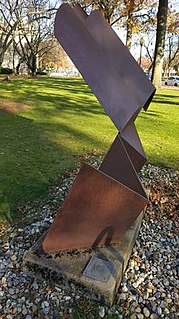
Angola is a 1968 Cor-ten steel sculpture by Isaac Witkin, installed on the Massachusetts Institute of Technology (MIT) campus, in Cambridge, Massachusetts, United States.

TV Man or Five Piece Cube with Strange Hole is a 1993 mountain rose colored granite and steel sculpture by David Bakalar, installed on the Massachusetts Institute of Technology (MIT) campus, in Cambridge, Massachusetts, United States. The five abstract, organic elements of the sculpture reflect the influences of Constructivism and Surrealism on the artist's style. The geometric forms use negative space to help compose an anthropomorphic ensemble.

La Grande Voile is a 1965 painted steel sculpture by Alexander Calder, installed in McDermott Court, on the Massachusetts Institute of Technology (MIT) campus, in Cambridge, Massachusetts, United States.

Transparent Horizon is a 1975 black Cor-ten steel sculpture by Louise Nevelson, installed on the Massachusetts Institute of Technology campus, in Cambridge, Massachusetts, United States. The artwork was among the first funded by MIT's "per cent per art" program, and has been the target of vandalism.


















